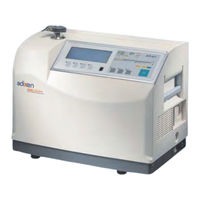Adixen ASM GRAPH D+ Manuals
Manuals and User Guides for Adixen ASM GRAPH D+. We have 1 Adixen ASM GRAPH D+ manual available for free PDF download: User Manual
Adixen ASM GRAPH D+ User Manual (337 pages)
HELIUM LEAK DETECTOR
Brand: Adixen
|
Category: Security Sensors
|
Size: 9 MB
Table of Contents
-
Description23
-
Overview26
-
Spray Method27
-
Options34
-
Metal Seals35
-
Languages35
-
Inlet Port35
-
Sniffing38
-
Accessories39
-
Spray Probe46
-
Printer46
-
2005 IS Pump51
-
Generalities62
-
Pump Labels65
-
Supplies70
-
Use73
-
Object74
-
Material74
-
Installation74
-
Test Ticket85
-
Control Keys93
-
Levels96
-
Change Password100
-
Other Menu102
-
Set Point Menu103
-
Spectro Menu104
-
Hard Vacuum Test113
-
-
Use and Display139
-
Inlet Vent141
-
Headphone142
-
Level Adjustment142
-
Configuration143
-
3 Masses Option146
-
Gas Selection146
-
Purpose146
-
Use Caution147
-
Selection Keys152
-
Memorized Graph155
-
Recording155
-
Point Measure157
-
Synoptic Reading160
-
Air Vent Purpose162
-
Inlet: Air Vent162
-
Bargraph Zoom164
-
Analog Display165
-
Adjustment167
-
Sound Level167
-
Zero Function168
-
Display170
-
Memo Function171
-
Zero Activated171
-
Display Timer172
-
Faults175
-
Minor Fault175
-
Critical Failure176
-
Major Fault176
-
List of Messages178
-
Icons Used198
-
Access Level 1199
-
Removable Cover199
-
Transportation208
-
Packaging208
-
Cell Disassembly210
-
Dismantling220
-
Cleaning220
-
Seal Preparation220
-
Reassembly221
-
Add Oil237
-
Tools ASM 142244
-
Pumping ASM 142254
-
Valves ASM 142256
-
Cover ASM 142260
-
Tools ASM 142 D268
-
Valves ASM 142 D279
-
Cover ASM 142 D283
-
Tools291
-
Measurement294
-
Pumping295
-
Valves295
-
Cover297
-
Analog Outputs317
-
Dimensions319
-
Flow Adjustment321
-
Filter Exchange322
-
Use Precaution328
-
Spare Parts328
-
Tools Contents331
-
Downloader332
-
Interface334
Advertisement
